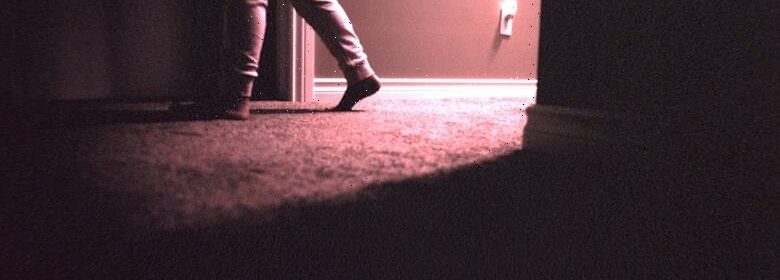Fearsome Efficiency: How ‘Skinamarink’ Built Its Horror Atmosphere with Microbudget Tools

“Skinamarink,” the low-budget first feature from Kyle Edward Ball, is an arresting-looking horror film designed to succeed within creative financial constraints. A stew of digitally-replicated film grain and oblique angles make what you see unnerving, but Ball designed “Skinamarink” so that what you hear from beyond the frame is truly the stuff of nightmares.
Filmed over a week in his parents’ house — where they blocked out all light using a combination of Blackwrap tape and black seamless paper — Ball and his team carefully constructed a house of horrors for siblings Kevin (Lucas Paul) and Kaylee (Dali Rose Tetreault), left alone and unsure of what might be in the house with them after their father mysteriously vanishes, and all openings in and out of the house abruptly disappear.
Ball’s film is a ticking tomb bomb of terror where wooden beam creaks and crackling carpet lead to the sensation of the children being hunted and the signifiers of childhood — toy phones, Legos, the blue light of a television screen — slowly warp until they are as wrong-looking and dreadful-sounding as a corpse.
The small budget and knowledge that prep work would be his saving grace allowed Ball to optimize for the best possible production scenario. “[My parents] could live in other parts of the house while we were filming, so that wasn’t an issue,” Ball told IndieWire. “They don’t have a car in the garage, so we got to use the garage for basically the art department. And then they have a TV room downstairs, that was not featured in the script, that they almost never use. So that was our ad-hoc video village. Well, not video village in the sense that we use it to monitor anything, but that’s where all the equipment went.
“But [what was most important was] planning everything so that it went off without a hitch. If you don’t plan for things, then just by osmosis, you can mess things up or burn a location. But if you plan for things, given time, then things seem to work out.”
“Skinamarink”
Shudder
The smooth and simplified shoot put the onus of bringing the film together on Ball in post. But once there, he used a set of visual and audio tools to age footage in the film and make the audio sound otherwordly and strange. “I had my set filter for making audio generically sound old. Originally, it was like three or four filters that I designed on my own. There was one reverb and then a bunch of other ones,” Ball said.
But when he wasn’t satisfied with the result, he eventually simplified the number of audio filters he placed over every sound and built specific audio tracks to manipulate moment by moment for the scariest sound. “With the soundtrack, I had two tracks: one for hiss and one for hum,” Ball said. “And shot by shot, I would do stuff like use it in lieu of room tone. I just like the way it sounds, more or less, and I like the way it makes me feel… I would play with pitch, with like the monster’s voice, and that was just one extra filter. And even then, a lot of [the monster’s sound] was just slowing down sound or speeding it up. I think there were like 10 audio tracks. But that was just because there was a handful of parts where I had a ton of layering. For most of it, [the film] was really living in about six tracks of audio.”
Six core tracks of audio is small for a feature film; “Everything Everywhere All at Once,” which had closer to a (still relatively small) $25 million budget, came up with 30 audio tracks in its first editing pass. But through the modulation of room tone and key sounds, especially when the image isn’t necessarily clear, changes in sound can seem powerful and terrifying, if not downright infernal. Leaning on his sound design didn’t mean that Ball could ignore the image. In fact, he had to have even tighter control over what the audience sees and can’t see throughout “Skinamarink.”
“Skinamarink”
Shudder
“The shooting script was used as a post-production script more than a filmmaker would, necessarily, because there’s a lot of parts where it’s like, ‘Is that just B-roll?’ And there’s a little bit of that,” Ball said. “[But the film is] not as constructed in the edit as you think. Like, it does literally say in the script, ‘The kids are talking as we’re looking at this corner of the living room.’ That’s all in the script.”
The script’s high level of detail, planning, and wordless storytelling also allowed Ball to shoot without recording sound, which allowed him to move faster and give specific direction to his young actors and also allowed for finesse when later recording the dialogue. “My amazing assistant director, Joshua Book Halter, took care of all the ADR with me, and we recorded it in the living room, tried to keep it intimate and quiet so that the actors could get into character without even trying. But we didn’t have all the lights off or anything because we didn’t want them to actually get creeped out and weirded out by it,” Ball said.
“It was a lot of lying [on the floor], reading with the kids, and then in post, [making it sound old with] just low pass, a little bit of reverb,” Ball said. “There was a little bit, too, of slowing down and speeding up of dialogue to change tone, but it all worked.” As the house morphs into something unknowable and the children’s whispers take on additional urgency, Ball’s soundscape drains the comfort from even a sibling’s voice — leaving just a final note of doom as the credits roll.
Source: Read Full Article


